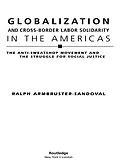Challenging sweatshop labor practices is extremely difficult, but garment workers, labor unions, and non-government organizations from Central America and the United States have successfully mobilized for better wages and working conditions over the past ten years. Those gains have not been broadened or sustained over time, however. This book examines why these various outcomes occurred through a comprehensive analysis of four "cross-border labor solidarity" campaigns. It concludes with some short, medium, and long-term strategies for addressing and potentially overcoming some of the obstacles that the contemporary anti-sweatshop movement currently faces.
Autorentext
Ralph Armbruster-Sandoval teaches in the Chicana/o Studies department at the University of California, Santa Barbara.
Zusammenfassung
First published in 2005. Routledge is an imprint of Taylor & Francis, an informa company.
Inhalt
Acknowledgments 1. Globalization and Cross-Border Labor Solidarity in the Americas: The Struggle for Social Justice 2. Globalization and Cross-Border Labor Solidarity in the Guatemalan Maquiladora Industry: The Phillips Van-Heusen Workers' Movement 3. The Salvadoran Maquiladora Industry and Cross Labor Solidarity: Bridging the Gap Between Image and Reality 4. The Honduran Maquiladora Industry and Cross-Labor Solidarity: The Kimi Campaign 5. Ni Un Paso Atrás! Not One Step Back! Chentex and Cross-Border Labor Solidarity in the Nicaraguan Maquiladora Industry 6. Globalization and Cross-Border Labor Solidarity: Is Another World Possible? Appendix A (Glossary of Organizations) References Index
